Sport Climbing 101: What Is It and How to Start (2024)

Published on: 05/05/2022
Last updated on: 05/08/2023
Are you interested in the sport of rock climbing but don’t know anything about it? Many potential climbers feel intimidated by the apparent difficulty of climbing. And also, the special gear, incomprehensible lingo, and other elements that create barriers for newcomers who might like to enter the sport.
Keep reading to learn everything you need to know about sport climbing, a style of rock climbing that anyone can learn and enjoy for a lifetime!
What Is Sport Climbing?

Sport climbing is a type of free climbing (meaning the climber only uses their own body to ascend the route, unaided by equipment) where the lead climber relies on pre-drilled permanent bolts to attach the rope for protection.
Therefore, pre-installed bolts distinguish sport climbing from other rock climbing disciplines. Indeed, in all other forms of technical roped climbing, a leader must carry and place all the gear they use for protection. This applies to alpine mountaineering, traditional rock climbing, ice and mixed (i.e., ice and rock) climbing, and aid climbing.
Established sport routes provide a relatively controlled environment for new climbers to learn leading and belaying skills. Thanks to the reliable protection and ease of clipping offered by bolt-protected routes, climbers can move faster and more lightly. Often it’s also safer than when practicing other types of climbing.
The Origin of Sport Climbing

From the Alps to Yosemite
In the early days of climbing, mountaineers and rock climbers employed various techniques to affix themselves and their ropes to the crag. They could use one end of the rope–or another short piece of cord–to tie in to naturally occurring boulders, chockstones, and other rock features.
Eventually, climbers in the European Alps began developing more modern types of equipment. By the early 1900s, they had invented or adopted pitons and carabiners for climbing purposes. A climbing leader uses a hammer to pound pitons into seams and cracks in the rock face. Then, they secure their rope to the piton to protect a fall.
Climbers use carabiners to attach climbing ropes to pitons and other types of protective gear. They come in many shapes and sizes nowadays, but the first designs were oval-shaped and made of steel.
After WWII, climbers in the Americas and Europe developed new equipment and techniques to conquer greater challenges than ever. This evolution included nylon ropes and webbing, climbing shoes, camming devices, other protection, drilled bolts, etc.
These innovations led to more advanced styles of aid climbing, fast and light mountaineering, big wall rock climbing, and single-pitch free climbing at increasingly difficult levels.
Sport Climbing’s Beginning
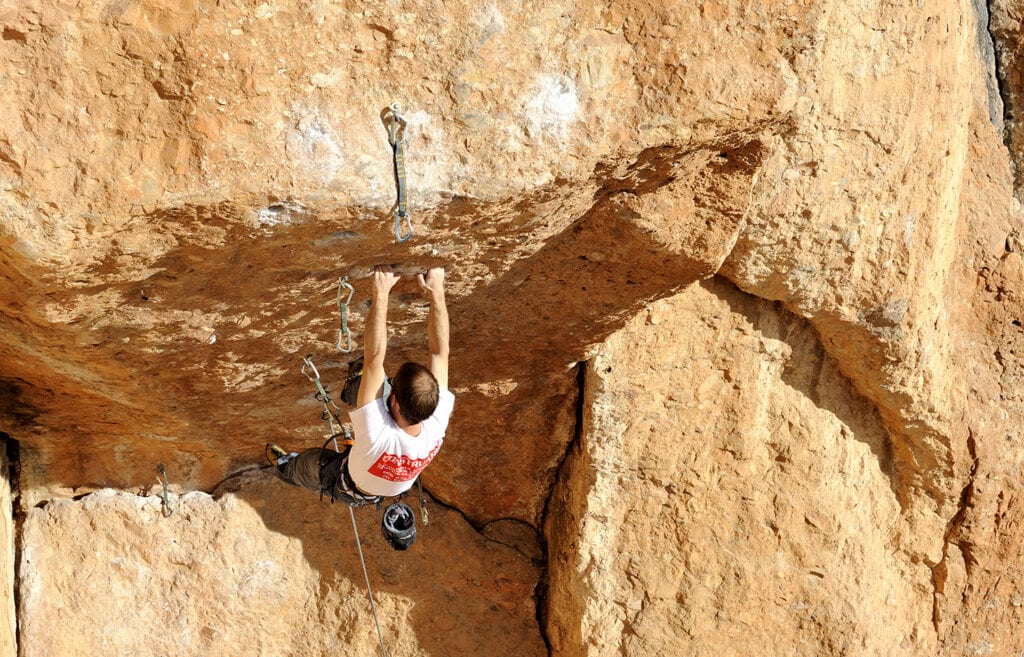
Still, it wasn’t until the 1970s and 80s that the modern version of sport climbing was born in France and the USA. As mentioned, this means holes have been drilled into the rock and expansion bolts installed at reasonable intervals to protect a lead climber from serious injury in the event of a fall.
The leader need not carry their own pitons, hammer, or cams and metal nuts. They don’t need to slow down while placing protection. She simply clips a quickdraw to a bolt, clips her rope to the quickdraw, and continues upward.
This style quickly spread from areas like Smith Rock in the United States and Buoux, France, to dominate the climbing world. And not only outdoors, but with the invention of the artificial climbing wall and indoor climbing gym soon after.
What Is the Difference between Sport vs. Trad Climbing?
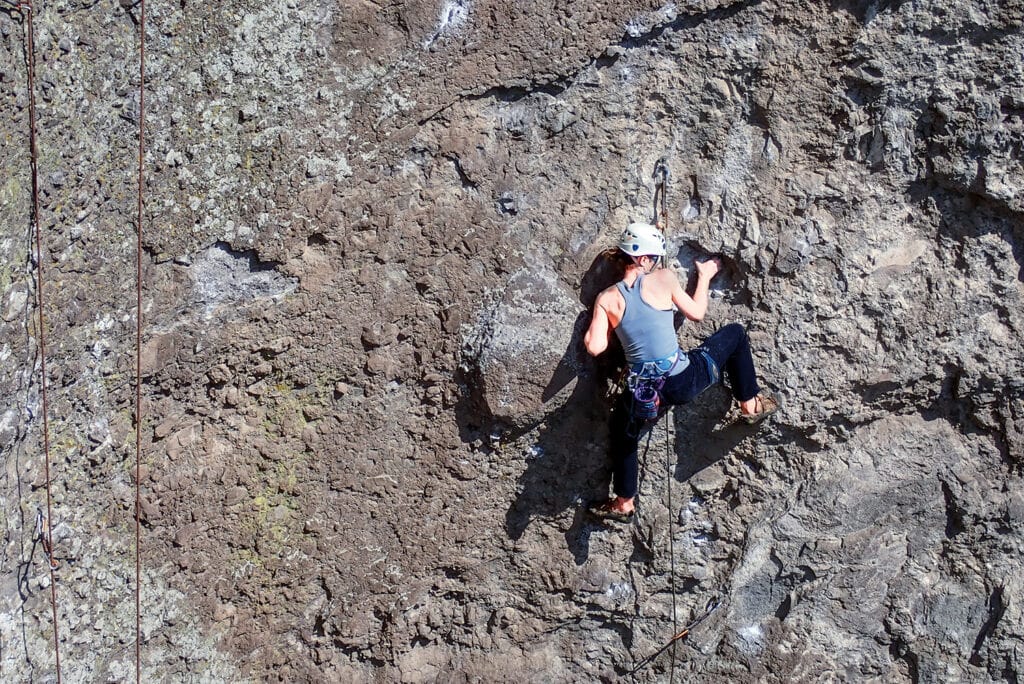
The two most popular, and sometimes competing, styles of rock climbing are sport and trad.
Trad climbing, which is short for “traditional climbing,” designates a set of gear and techniques and an aesthetic. The purest impulse of trad climbing is to climb in the cleanest method possible, meaning leaving no permanent trace of your passing.
That also means using one’s own equipment for protection and removing it before leaving, rather than relying on bolts or any other semi-permanent hardware. That being said, most trad climbers accept the occasional bolt installed to create a safe anchor or to protect a featureless section of rock.
For a complete breakdown of the differences between sport and traditional climbing, check out our Trad vs. Sport Climbing: 5 Major Differences article.
Sport Climbing Terminology and Slang
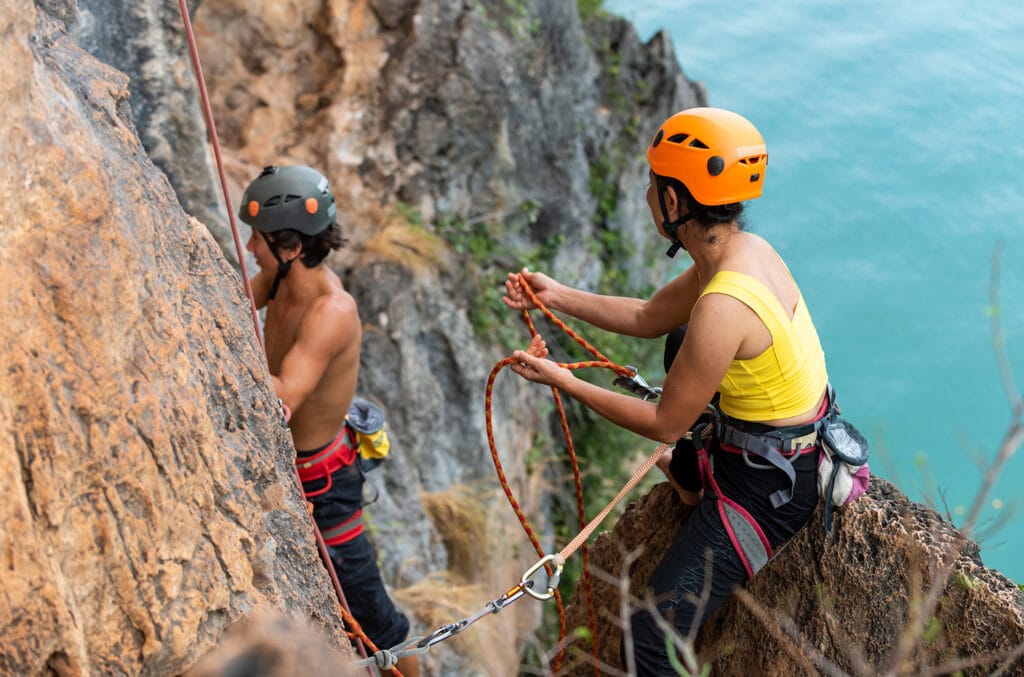
One thing you should understand is that “sport climb(ing)” can be a noun, verb, or adjective. Examples: “He’s not into cracks; he’s a sport climber.” “Want to go sport climbing this weekend?” “Is that a sport climbing route or a trad route?”
In addition, here’s a shortlist of vocabulary that you might want to be familiar with so you can communicate with your favorite sport climbers.
Belay / Belayer
A belayer holds onto the climber’s rope and feeds out slack, takes up slack, or stops the rope from moving as needed to arrest a fall or minimize its severity. Belaying involves using a belay device, a piece of gear that holds the rope and lets a user vary the friction to slow or stop the rope in a controlled manner.
Lead / Follow
A leader, or lead climber, ties in to a rope coiled on the ground and climbs up until they reach an anchor or belay stance. The leader then lowers or rappels down from the anchor or belays the next climber up. A follower is a climber who is not leading but is climbing on the rope that the lead climber secured.
Multi-pitch route
A route that ascends more than a single pitch and requires the leader of each pitch to belay their partner from above. Multi-pitch sport routes can be from two pitches up to more than 20 pitches in length.

Onsight / Redpoint
If you walk up to a bolted sport line that you haven’t ever seen and climb the route cleanly without hanging on the rope or falling, you have “onsighted” the route. If you climb a route cleanly only after a first initial attempt, you “redpointed” the route. Some successful redpoint sends take years of work and practice.
Pitch
A pitch was traditionally one rope length so that a leader could move as far as possible before having to build a new anchor. In the case of a single-pitch route, a pitch must always be less than one-half the length of your rope. This allows a climber to safely ascend and lower without running out of rope.
Project
A more challenging route than your current abilities allows you to climb. You set it as a future goal to work toward.
Send
To successfully reach the top of a route without falling.
Top-rope
A route where the rope is already anchored at the top of a pitch before the climber begins to ascend. Top roping reduces the length of potential falls to practically nothing, so it is the most common method for beginners to learn basic climbing and belaying techniques.
Sport Climbing Grades
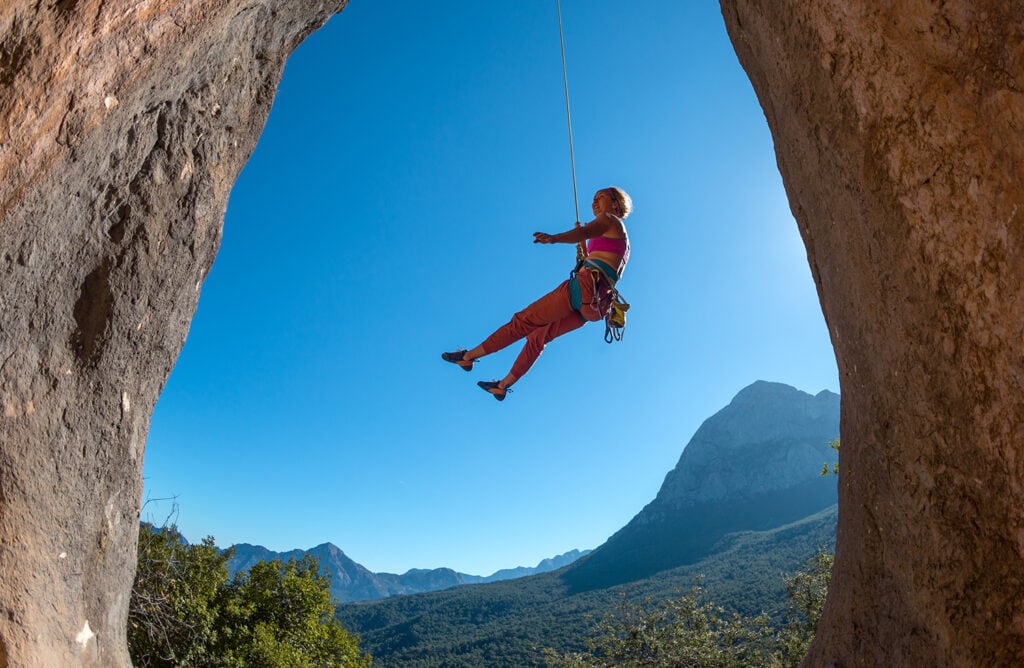
Sport climbing routes are rated according to difficulty. This helps climbers choose an appropriate route according to their individual abilities and objectives.
Many climbing grading and rating systems have been developed throughout the world. The most commonly used for sport are the Yosemite Decimal System (YDS) and the “French” Grading system.
See our Ultimate Guide to Climbing Grades article for a complete explanation and comparison of grading systems.
Sport Climbing at the Olympics

The International Olympic Committee and the International Federation of Sport Climbing introduced Sport Climbing as a new Olympic medal event in 2020. This has brought greater attention and worldwide attention to the sport.
The Olympic form of competition includes three distinct climbing disciplines; all practiced indoors on an artificial climbing wall:
- Lead climbing
- Bouldering
- Speed climbing.
Major Athletes Competing in Olympic Sport Climbing
Many of the climbing world’s brightest stars worked hard for the opportunity to qualify and represent their respective countries at the inaugural event in Japan.
Top professional and World Cup climbers who made appearances included Adam Ondra of the Czech Republic, Alexander Megos (Germany), Tomoa Norasaki (Japan), and Shauna Coxsey (Great Britain).
Sport Climbing at the Tokyo Olympics 2020

Sport climbing debuted at the 2020 Tokyo Olympic Games, which actually took place in 2021.
All competitors in Tokyo were required to participate in each of the three disciplines, and their individual results were combined into one total score to determine the medal winners.
The final results in the 2020 Olympic debut of competition climbing were surprising to some. Several of the biggest stars of the international climbing scene didn’t make it to the podium.
Here are the 2020 Olympic Sport Climbing medal winners:
Men’s Medalists
Gold – Alberto Ginés López (Spain)
Silver – Nathaniel Coleman (United States)
Bronze – Jakob Schubert (Austria)
Women’s Medalists
Gold – Janja Garnbret (Slovenia)
Silver – Miho Nonaka (Japan)
Bronze – Akiyo Noguchi (Japan)
2024 Paris Olympics Sport Climbing Competition

The next Summer Games in 2024 will occur in Paris, France. Based on feedback from climbers and the overwhelming popularity of the first competition, the Olympic committee will slightly alter the format of the next event.
In the 2024 Olympics, rock climbing will be separated into two medal events. Lead Climbing and Bouldering disciplines will be combined into one event, while Speed Climbing is split off into its own medal category.
That means twice as many medals available for the global climbing community, so start training!
Core Concepts of Sport Climbing

Rope and Gear Management
The most fundamental skill you need to master before attempting your first sport climbs is belaying. The belayer shares the ultimate responsibility for keeping their partner safe while on route. You need to be able to stop a fall without thinking, which demands awareness of your surroundings and a thorough knowledge of your gear and techniques.
For more about belaying your partner on lead or top rope, see our beginner’s guide to belaying.
Pre-Climb
Before a lead climber leaves the ground, make sure, and check that :
- Leader and belayer’s harnesses are adequately secured
- The climber is tied in with a figure-8 knot or another appropriate knot
- The rope is properly fed through the belay device.
- The leader has the proper gear to protect the chosen route and anchor building material if necessary.
Make sure both of you feel confident in your communication system and ability to signal critical information to your partner. Discuss whether the leader will lower, rappel, belay the second from above, etc. If there is any detail nagging at your mind, now is the time to ask or say something!
During the Climb
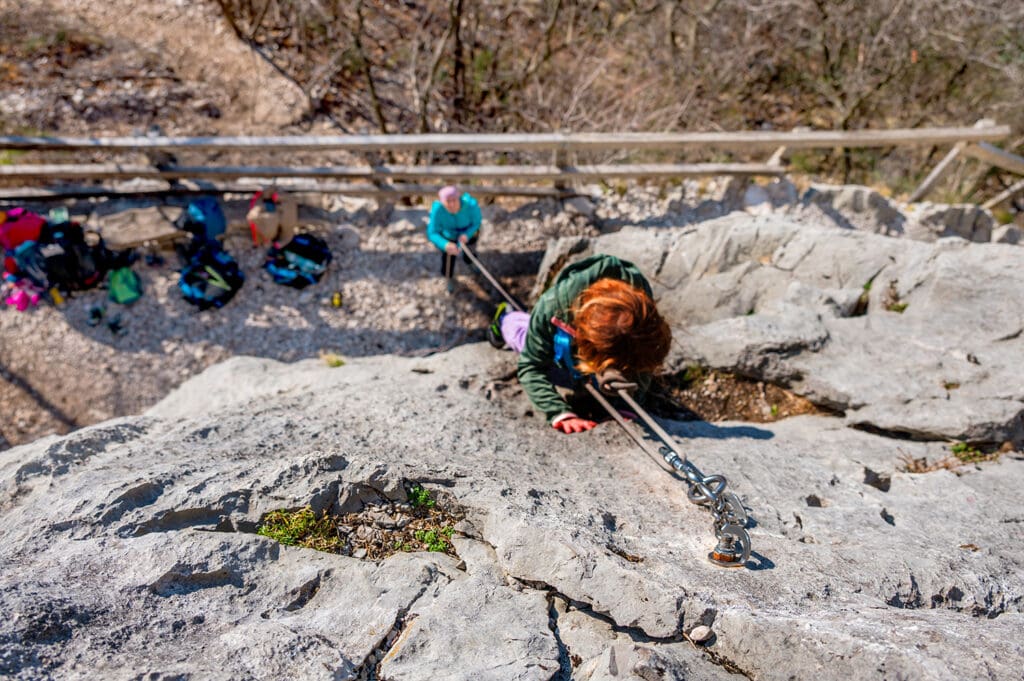
A sport climbing leader, like a belayer, has several tasks to master to maximize their safety and chances of success. First, managing the rope while climbing and clipping. Then, attaching quickdraws to bolted hangers and one’s rope in the correct orientation.
At the top of a well-maintained sport route, a leader ideally finds a solid anchor consisting of two or more bolts with hangers and gear that allows one to feed a rope through. This consists of chains, hooks, quick links, rings, or a similar setup. A sport leader needs to be capable of dealing with these variables and making good decisions in the face of unpredictable conditions.
Sport Climbing on an Indoor Wall
Indoors, things are much simpler. Most gyms have quickdraws already hung on their sport climbing lead routes, along with large hooks or carabiners at the top from which to lower. So, the only gear required to lead climb is a harness, rope, and belay device. You’ll just need a device and a harness for indoor top ropes.
Sport Climbing Techniques

Climbers naturally learn to use their hands, feet, and body positioning more efficiently as they practice and get more experience.
Smaller handholds are called crimps or “crimpers.” Large holds that you can easily grasp and hang off are “jugs.” Many finger injuries occur from overusing crimp-style grips on small holds. We can use a more “open-hand” grip on jugs, which puts much less strain on your finger tendons and ligaments.
When it comes to footwork, using your toes to cling to a small ledge or protruding feature is called “edging.” If you use the bottom of your climbing shoe sole to create friction against a flat rock section with no discernible features, that’s referred to as “smearing.” Using the top of your toe or the back of your heel to grasp a hold is “hooking.”
Training for Sport Climbing

Climbing gyms emerged as a place for outdoor climbers to train for more serious pursuits on real rock. Of course, nowadays, many climbers start climbing in the gym and never venture outside to practice their sport.
Most climbing gyms have training areas with climbing-centric equipment like tread walls, moon boards, hangboards, and other devices. Yoga, pilates, and other core strengthening exercises are also very popular with climbers seeking an edge.
How To Start Sport Climbing
The quickest and most accessible method for many people to begin sport climbing is signing up for a lesson at a nearby climbing gym. At most facilities, you’ll be able to top rope and boulder right away on your first visit. Climbing shoes are often provided or avaible for rent.
Lead climbing requires more experience and a separate course focused on leading skills.
However, perhaps the best way is to ask a friend who is an experienced climber if you can tag along on a few sessions and learn the basics. Members of the climbing community are more often than not eager to share their knowledge and love of climbing.
We discuss all the best ways for beginners to get into the sport in our how-to-start rock climbing guide.
Famous Sport Climbing Areas
There are sport climbing areas with previously established bolted routes all around the world.
Here are a few of the top locations to help you start researching your next climbing vacation:
- Céüse, France
- Siurana, Spain
- Red River Gorge, USA
- Frankenjura, Germany
- Dolomites, Italy
Equipment Needed for Sport Climbing

We’ve already discussed most of the gear you’ll need to start sport climbing. Here are a few more details on the necessary items.
Dynamic Climbing Rope
Ropes made for climbing are woven with nylon and designed to stretch (up to 30%) to reduce the impact force when a climber falls. A rope that doesn’t stretch is “static.” You should never sport climb on a static rope. The most common sizes of ropes are 60 and 70 meters in length and 9.0 – 10.5 mm in diameter.
Quickdraws
A quickdraw consists of two carabiners (usually D-shaped) connected by a fabric sling called a “dogbone.” A lead climber clips each bolt on a sport route with one end of the quickdraw and clips the rope to the other end. For most sport routes, 12-15 quickdraws are all you need to protect the route.
Belay Device and Carabiner

You’ll need a device to belay your partner and a locking carabiner to attach the device to your harness. Belay devices either allow the operator to completely control the level of friction and braking (for example, the Black Diamond ATC) or use some camming action on the rope to help the belayer slow it down. The most well-known of these assisted-braking devices is the Petzl GriGri.
Harness
Purchase a harness specially designed for climbing, not tree climbing or working trades. Climbing harnesses have built-in gear and belay loops, along with materials and construction made to withstand the unique stresses of rock climbing.
Personal Anchor System (PAS)
A lead climber uses a personal anchor system to attach himself to the anchors at the end of a pitch. This allows the leader to go off belay and untie from the rope, if necessary, to thread it through the anchors and prepare to lower or rap down.
Helmet
Outdoor climbers and belayers should wear climbing-certified helmets. Helmets can prevent or lessen head injuries caused by rock fall and climbing falls.
For more detailed information on the gear required for sport climbing, check out our in-depth article: Sport Climbing: The Ultimate Gear List (2024 Guide)
Frequently Asked Questions (FAQs)

Yes, since it debuted at the 2020 Tokyo games. The next Olympic sport climbing competitions will take place in Paris in 2024.
Lead climbing is one method for reaching the top of a sport climbing route whereby the lead climber clips in the rope as they ascend. Note that lead climbing is also used in other roped-climbing styles like trad climbing and aid climbing. The opposite of lead climbing is top roping.
Not necessarily. While boulder problems tend to concentrate sustained, highly difficult moves into a short span, sport routes can take much more endurance and still contain extremely difficult sequences of moves. Sport climbs are also not as consistently steep as boulders and often rely more on technical footwork and balance than power and strength.
Experienced climbers consider sport climbing to be one of the safer styles. Most sport routes are designed to protect leaders from long, potentially dangerous falls. Tricky moves on sport climbs usually come with a handy bolt nearby that provides physical security and mental support. In reality, the majority of sport climbing accidents happen because of human error, not equipment failure or environmental hazards.
Yes, top roping is part of sport climbing. With top roping, the rope is already secured to the top of the route. It’s safer and easier than lead climbing making it popular to begin sport climbing. However, ascending a sport with a top rope doesn’t count when it comes to official records. When elite climbers send new routes (e.g. Chris Sharma’s recent first ascent of Sleeping Lion in Siurana, Spain), they always do so lead climbing.
